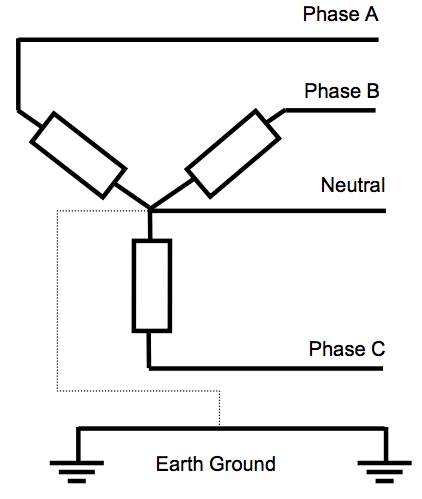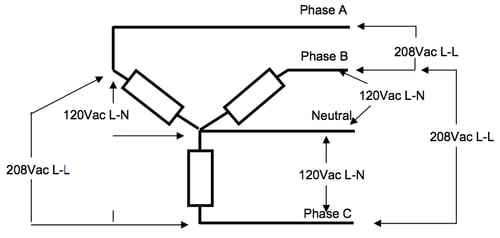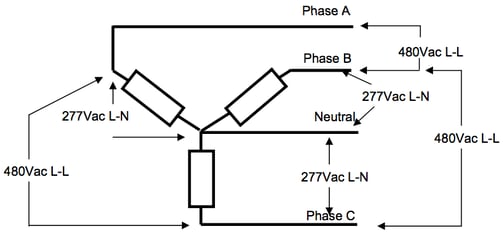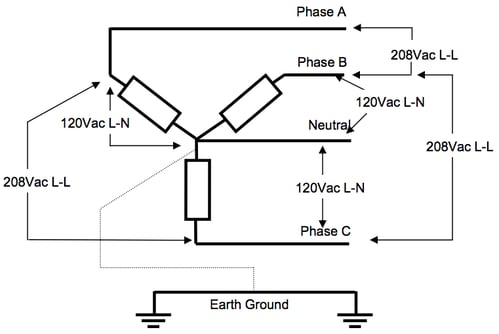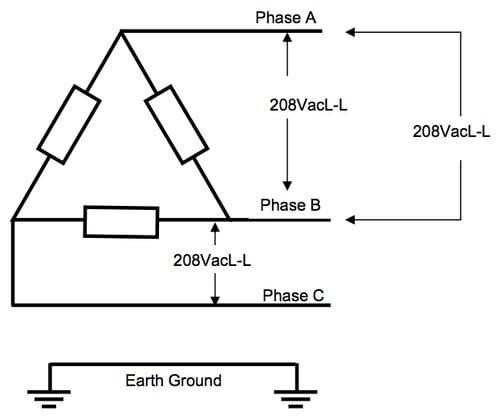Providing AC power to your AMETEK Programmable Power source can be confusing. The reason for this is that there are several different configurations for three-phase power. What you first need to do is to identifying the different power configurations that may be in your facility and then decide how to connect it to your power source.
Three-phase AC power is usually distributed in a facility in a configuration consisting of 5 wires. Three of the wires are current carriers and are called phases. These three phases are 120 degrees out of phase with each other. The fourth wire is the neutral wire. The neutral wire will not have current flowing in it as long as the current in the three phases are matched. The 5th wire is Earth Ground. This configuration, shown in Figure 1, is commonly called a three-phase wye configuration because of the Y shape of the phases.
In the USA the most common configuration is 208Y/120, shown in Figure 2. This indicates that line to line (L-L) voltage is 208 VAC in a WYE configuration and the line to neutral (L-N) voltage is 120 VAC. It is also sometimes called 120/208 VAC, 120/208 WYE, 208/120 WYE, 4 wire WYE or 120/208 Y. Most AMETEK Programmable Power sources that supply more than 5 kW will operate on this configuration.
For applications that require higher power, you may need the 480Y/277 configuration, shown in Figure 3. In this configuration, the line to line voltage is 480 VAC in a WYE configuration and the line to neutral voltage is 277 VAC. This configuration is often an optional configuration for AMETEK supplies 5 kW and larger.
Since each phase in a three-phase wye configuration is 120 degrees out of phase with the others, the L-L voltage is not the algebraic sum of the L-N voltages but a vector addition. A quick method that can be used if the phase angles are 120 degrees apart is to use the L-N voltage multiplied by √3.
VL-N ∗ √3 = VL-L (i.e. 120 VAC ∗ 1.7333 = 208 VAC)
VL-L ÷ 1.7333 = VL-N (i.e. 480 VAC ÷ 1.7333 = 277 VAC)
Another variation of the four-wire WYE configuration is the five-wire wye configuration that adds an Earth Ground wire which is usually connected to neutral at the circuit breaker panel. See Figure 4.
Although the WYE configuration is the most common configuration, the Delta configuration, shown in Figure 5, is also found in many facilities. In this configuration, there is no neutral wire, so the voltage is always a line to line measurement.
Vline = Vphase (i.e. 208 VAC = 208 VAC)
Iline = √3 x Iphase (If the phase current is 50 A, the line current is 1.733 x 50 A = 86.6 A)
One advantage of a Delta configuration is that it does not have a neutral and therefore if a phase winding should fail the phase voltage at the load will remain constant.
Before you connect the power to an AMETEK Programmable Power source, be sure to double check the voltages. If you have any questions, contact us by e-mail at sales@programmablepower.com, or phone 858-458-0223.


